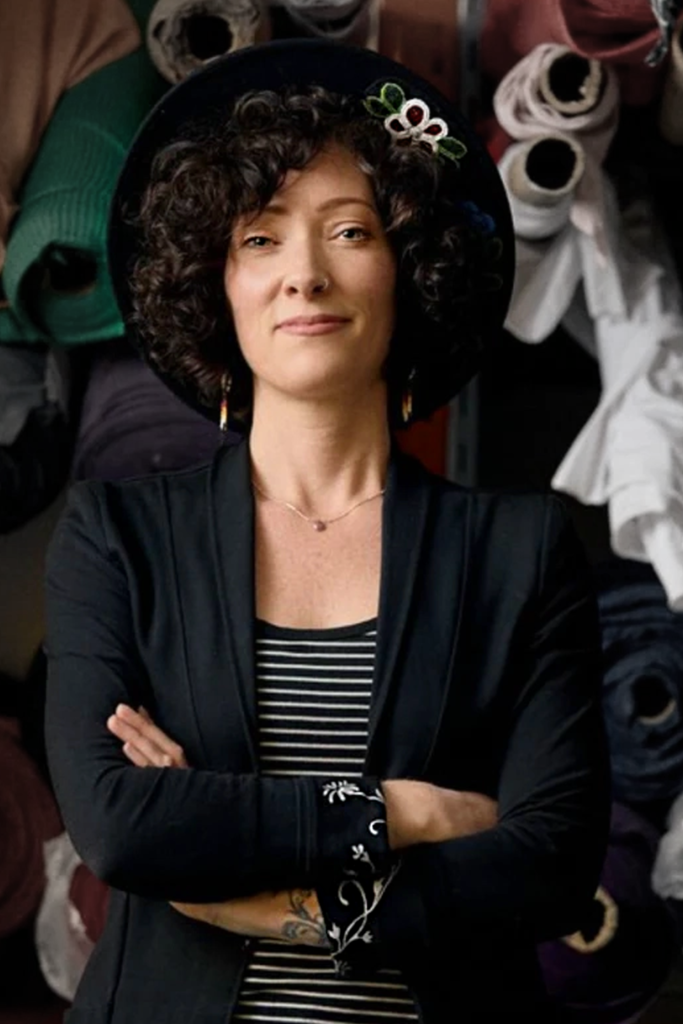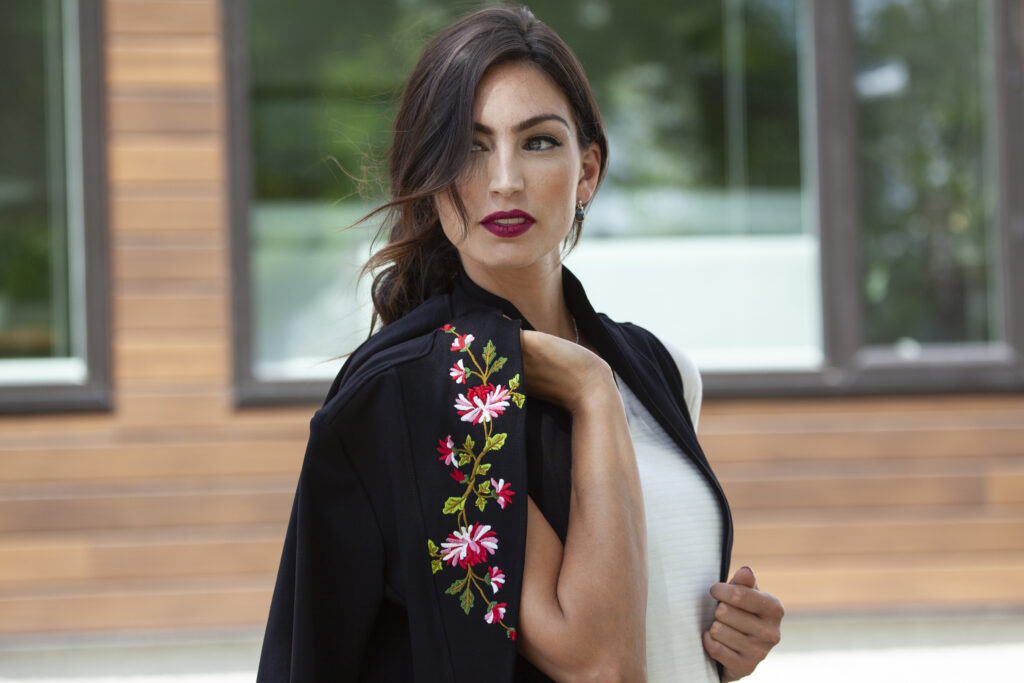The fashion industry in Manitoba is still leading the pack in trends and inspiration
By Dorothy Dobbie
Most people think success happens overnight, but that night can take 18 long years. That’s how long ago Andréanne Dandeneau, the visionary CEO behind dynamic fashion brand Anne Mulaire, started to work on her dream. Today, Anne Mulaire is at the leading edge of two fashion trends, the interest in Metis and Indigenous artistry and sustainable practices.
“Creativity has been an integral part of my life since my early years,” she says. “I have always been fascinated by design and expressing myself through various artistic mediums. When I was 15, I was a contemporary dancer and began creating costumes for dance shows.” She went on to study design at the LaSalle College School of Fashion Design in Montréal. “My experience in learning how the body moves gave me an advantage in creating my first clothing line in 2005.”

The rich cultural tapestry of the Red River Metis Nation has significantly influenced her approach to fashion. Drawing inspiration from her heritage, Andréanne has skillfully woven together traditional Indigenous artistry with contemporary design, creating a unique and captivating aesthetic that sets Anne Mulaire apart in the fashion industry.
Andréanne started her business in her parent’s basement in St. Boniface, the community where she was born and raised as part of the Metis community to parents David and Huguette (Mulaire) Dandeneau. Her mother comes from the Red River Valley and her father comes from Penetanguishene, Treaty 61. One of Anne’s most influential ancestors is Catherine Mulaire, who was born in 1843 in Ile de La-cross. She was the first rural Anishinaabe/Métis teacher in the Red River Settlement and an accomplished seamstress whose embroidery continues to inspire the designs of Anne Mulaire.
Can Andréanne fit you?
Anne Mulaire fashions are designed to dress real bodies and the size range reflects the reality of needs. Beginning with the brand name Hug me and offering a line of comfort clothing, Anne Mulaire has evolved with a line that is more structured but still comfortable. Sizes range all the way from a tiny size xxs2 up to 6X (up to a 77-inch hip), and design can be subtly altered to suit your body type.
Since the beginning of my company, I have collaborated with my dad, David, who is our Metis Elder at Anne Mulaire. He is also the talented artist behind all the prints you see on our garments,” said Andréanne. “Initially, he hand-painted the garments, but as the number of orders grew, we realized that this was not sustainable. However, he still hand paints on some garments for fashion shows. These unique pieces hold a special place in my collection.”
As a passionate advocate for inclusivity and cultural preservation, Andréanne’s leadership goes beyond the confines of the fashion world. She is on a mission with Anne Mulaire to celebrate diversity, promote ethical fashion, and uplift the voices and talents of Indigenous artisans. Through the brand’s initiatives, Andréanne is not merely designing clothing; she is crafting a narrative of empowerment and cultural resurgence.
A pioneer in the realm of conscious fashion, her commitment to sustainability is evident in Anne Mulaire’s practices, which focus on environmentally friendly materials and ethical sourcing.
“Growing up in my Metis heritage, I was immersed in a culture that revered nature and sustainability. My parents and grandparents were staunch advocates of living in harmony with Mother Earth. This instilled in me a deep-rooted connection to the land,” she explains. “I was raised amidst the use of natural fabrics, learning from their teachings. This underscored the importance of sustainability and the art of living with only what one needs.”
This upbringing cultivated a profound love for the environment and fueled her passion for discovering new sustainable textiles. “As I became increasingly aware of the environmental impact and excessive waste within the fashion industry, my Metis heritage became a guiding force, propelling me to explore and champion fabrics that would embody both cultural reverence and ecological responsibility.”
To that end, Andréanne has explored different fabrics. One of the newest and most interesting is Tencel. “We work with several sustainable fabrics, including linen, bamboo, organic cotton, and the newest one, Tencel. Tencel is made from eucalyptus pulp and has a luxurious, silky feel. It is also environmentally friendly, with minimal water usage and low impact production processes compared to other fabrics like bamboo. We work with various knitters in Ontario and the USA who follow ethical practices to create our Tencel fabric. This fabric is highly breathable, soft, and can even be transformed into a cashmere-like fabric for a cozy winter feel.”

One of Anne Mulaire’s flagship initiatives is the “Return to Nature” program, a holistic approach to reducing waste in the fashion industry from a circular perspective.
This initiative encompasses six innovative programs: Refresh (repairs), Resale, Revive (repurpose), Downcycle, Biocycle, and Fiber Lab (recycling).
The Refresh/Repairs program encourages customers to bring back their well-loved Anne Mulaire pieces for refreshing and repairs to extend the lifespan of each garment.
Through Resale, the brand facilitates a second-hand marketplace for its creations, promoting a circular economy and reducing the environmental impact of fast fashion. They will use material rescued from old garments in the creation of new clothing.
The Revive/Repurpose program takes a creative approach to sustainability by encouraging customers to reimagine their old Anne Mulaire pieces. By providing ideas and resources for repurposing garments, this initiative transforms fashion into a form of self-expression and environmental responsibility. This is a great way to keep up with fashion trends by altering garments that have grown a little stale.

The Downcycle program focuses on responsibly managing textiles that have reached the end of their life cycle, ensuring that materials are repurposed in an environmentally friendly manner. In a groundbreaking move towards biodegradability, the Biocycle program explores innovative materials and processes that return garments to nature harmlessly — in order words, they explore how long it takes for a fabric to break down and return to a natural state.
Lastly, the Fiber Lab/Recycling program delves into cutting-edge recycling technologies, aiming to create a closed-loop system where materials from old Anne Mulaire garments are transformed into new ones, minimizing the demand for virgin resources.
Through these six interconnected programs, the Return to Nature initiative sets Anne Mulaire apart as a pioneer in sustainable fashion. Andréanne’s commitment to a circular approach not only addresses the environmental impact of the fashion industry but also encourages consumers to participate actively in the life cycle of their clothing.
In conclusion, Andréanne Dandeneau’s journey from the basement to the forefront of the fashion industry is a story of resilience, creativity, and social responsibility. Her commitment to celebrating Indigenous culture, promoting ethical practices, and empowering communities sets a precedent for the fashion industry to follow. Anne Mulaire is not just a brand but a testament to the transformative power of fashion when guided by a visionary leader with a deep sense of purpose.
Andréanne’s impact extends far beyond the garments she designs. She hopes to leave an indelible mark on the industry and help pave the way for a more inclusive, sustainable, and culturally enriched future in fashion.


